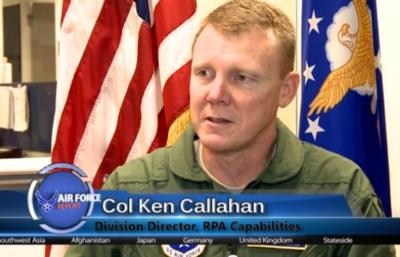Tue, Apr 08, 2014
Twenty-Five-Year Vision For RPAs Gives Private Sector Guidance For Manufacturing
Air Force leaders outlined what the next 25 years for remotely piloted aircraft will look like in the RPA Vector, published April 4. “The RPA Vector is the Air Force’s vision for the next 25 years for remotely-piloted aircraft,” said Col. Kenneth Callahan, the RPA capabilities division director. “It shows the current state of the program, the great advances of where we have been and the vision of where we are going.”

The goal for the vector on the operational side is to continue the legacy Airmen created in the RPA field. The vector is also designed to expand upon leaps in technology and changes the Airmen have made through the early years of the program. “The Airmen have made it all about supporting the men and women on the ground,” Callahan said. “I couldn’t be more proud of them for their own advances in technology to expand the program, making it a top platform.”
The document gives private corporations an outlook on the capabilities the Air Force wants to have in the future, ranging from creation of new RPAs to possibilities of automated refueling systems. “There is so much more that can be done with RPAs,” said Col. Sean Harrington, an intelligence, surveillance, and reconnaissance command and control requirements chief. “Their roles (RPAs) within the Air Force are evolving. We have been able to modify RPAs as a plug-and-play capability while looking to expand those opportunities.”
In recent years, RPAs not only supported the warfighter on the ground, they also played a vital role in humanitarian missions around the world. They provided real time imagery and video after the earthquake that led to a tsunami in Japan in 2011 and the earthquake in Haiti in 2010, according to Callahan. Then, most recently, during the California Rim Fire in August 2013, more than 160,000 acres of land were destroyed. Though this loss was significant, it was substantially decreased by the support of the California Air National Guard’s 163rd Reconnaissance Wing, with support from an MQ-1 Predator, a remotely piloted aircraft.
With this vector, technologies may be created to improve those capabilities while supporting different humanitarian efforts, allowing the Air Force to support natural disaster events more effectively and timely.
The future of the Air Force’s RPA programs will be continuously evolving, to allow the Air Force to be the leader in Air, Space, and Cyberspace. “We already combine our air, space and cyber forces to maximize these enduring contributions, but the way we execute must continually evolve as we strive to increase our asymmetric advantage,” said Gen. Mark Welsh, the Air Force chief of staff. “Our Airmen's ability to rethink the battle while incorporating new technologies will improve the varied ways our Air Force accomplishes its missions.”
(Image provided by the U.S. Air Force)
ANN Salutes Staff Sgt. Carlin Leslie, Air Force Public Affairs Agency
More News
Circle To Runway (Runway Number) Used by ATC to inform the pilot that he/she must circle to land because the runway in use is other than the runway aligned with the instrument appr>[...]
Aero Linx: National Aviation Safety Foundation (NASF) The National Aviation Safety Foundation is a support group whose objective is to enhance aviation safety through educational p>[...]
At Altitude Of About 250-300 Ft Agl, The Airplane Experienced A Total Loss Of Engine Power On November 6, 2024, at 1600 central standard time, a De Havilland DHC-1, N420TD, was inv>[...]
From 2009 (YouTube Edition): Three Hour Flight Was 'Flawless' -- At Least, Until Mother Nature Intervened For anyone who loves the aviation business, this was a VERY good day. Afte>[...]
Also: AMA Names Tyler Dobbs, More Falcon 9 Ops, Firefly Launch Unsuccessful, Autonomous F-16s The Air Force has begun ground testing a future uncrewed jet design in a milestone tow>[...]
 ANN's Daily Aero-Term (05.05.25): Circle To Runway (Runway Number)
ANN's Daily Aero-Term (05.05.25): Circle To Runway (Runway Number) ANN's Daily Aero-Linx (05.05.25)
ANN's Daily Aero-Linx (05.05.25) NTSB Prelim: De Havilland DHC-1
NTSB Prelim: De Havilland DHC-1 Classic Aero-TV: The Boeing Dreamliner -- Historic First Flight Coverage
Classic Aero-TV: The Boeing Dreamliner -- Historic First Flight Coverage Airborne-NextGen 05.06.25: AF Uncrewed Fighters, Drones v Planes, Joby Crew Test
Airborne-NextGen 05.06.25: AF Uncrewed Fighters, Drones v Planes, Joby Crew Test



